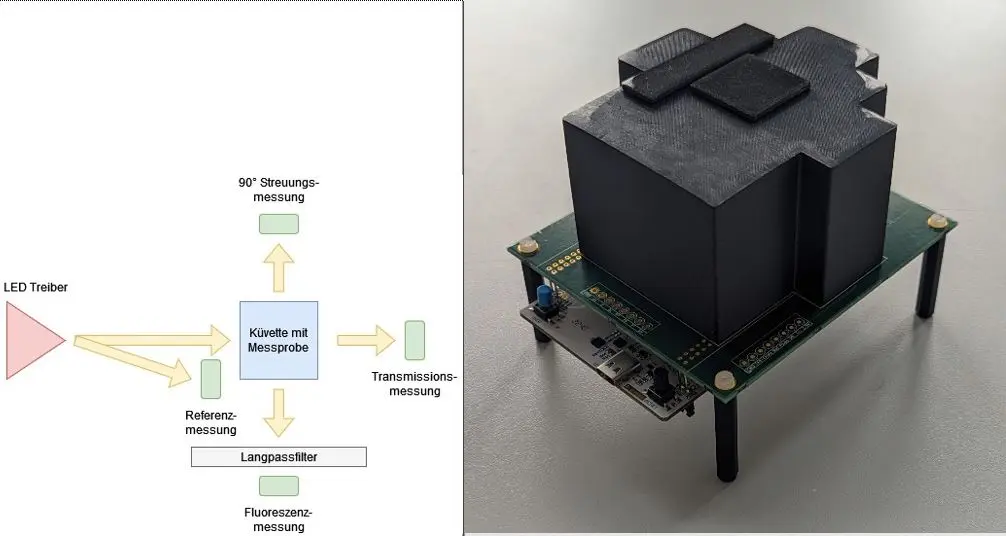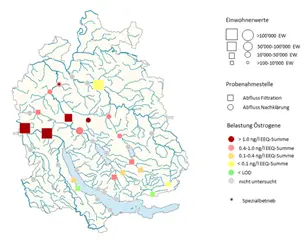Analysis methods for circular systems
The updated EU Water Framework Directive aims to ensure cleaner rivers, lakes, groundwater and seas in the EU by 2040 and to reduce the costs of wastewater treatment. As part of this process, the list of water pollutants is being revised, a process that Switzerland is following closely. Advanced monitoring of surface water and groundwater requires new, more sensitive measurement methods.
In addition to traditional chemical analyses, scientifically recognised, effect-based methods will be used in the future to determine the effects of pollutants and their trigger levels. For example, such methods are crucial for identifying oestrogenic substances in water, which can have a significant impact on the sexual development of fish and other organisms even at very low concentrations.
Since 2011, our Ecotechnology research group has been developing such biotests, in particular planar biotests, which can sensitively detect genotoxic and oestrogenic substances in water samples.
At the same time, we are working on the development of low-tech sensors to enable continuous monitoring. The development of these methods is highly relevant for the implementation of water recirculation systems, such as in the KREIS-Haus. In addition to monitoring methods, suitable parameters must also be developed to ensure the safe use of self-sufficient water circulation systems with grey water treatment and direct water recycling.
Genotoxic substances in recycled PVC flooring
In collaboration with the ZHAW spin-off planar4,12 selected extracts from PVC flooring (from a total of 144) were analysed in 2022 using the planar-umuC bioassay. Genotoxic activity was detected in 11 of the 12 extracts analysed using the planar-umuC bioassay. This result shows that such substances can also appear in new PVC flooring through the recycling of old PVC flooring.
Reference: Wiesinger, H., 2024, Legacy and emerging plasticizers and stabilizers in PVC floorings : impacts of an industrial transition and recycling, Environmental Science & Technology, (https://pubs.acs.org/doi/10.1021/acs.est.3c04851 )
Oestrogenic effect in wastewater samples
Water quality in Switzerland has improved considerably thanks to advanced treatment processes, such as the introduction of a fourth treatment stage. Despite this progress, micropollutants from smaller wastewater treatment plants and other diffuse sources such as drainage systems remain a challenge. Micropollutants of concern include oestrogenic compounds such as estrone (E1), 17β-estradiol (E2) and the synthetic hormone 17-ethinylestradiol (EE2), which can cause ecological problems even at very low concentrations.
A 2016 study of 20 wastewater treatment plants in Zurich using the Planar Yeast Estrogen Screen (planar-YES) revealed the presence of these estrogenic substances in 16 plants. Estrogen activity above the recommended limit of 0.4 nanograms per litre was detected in half of the samples. The planar YES method shows its versatility and effectiveness in its broad applicability for monitoring.water pollution.
Sensors for monitoring circulation systems

Our project will begin with a comprehensive analysis and evaluation of proven techniques for monitoring the quality of treated grey water, including sensor-based approaches such as SAC254 probes. Building on this, methods will be tested in existing water reuse projects with the aim of developing these techniques into efficient and cost-effective monitoring solutions.
Casa Circolo
The feasibility study "Casa Circolo" examines the technical aspects of the implementation of a self-sufficient water circulation system with grey water treatment and direct water recycling using the example of the KREIS house in Feldbach ZH. The main topics are water quality (chemical-physical parameters, genotoxicity), energy requirements, water balance and the transfer of water and nutrient flows for fertilisation and irrigation (fertigation) in the sense of the "water-energy-food-ecosystem nexus".
